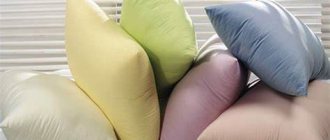The most important summer beachwear is the swimsuit. After spending time in stores looking for the right shade or the right cut, we finally found the model that suits us. Of course, we don't want our favorite beachwear to fade before the season is over. Sea water or chlorine, sand, sunscreen and even sunlight can damage the materials of this garment. So, how do you properly wash and care for your swimsuit to keep it in good condition? In this article, you will also learn how to remove stubborn and difficult stains such as oil, and how to remove sand that has accumulated inside a swimsuit.
Factors that affect fabric
Modern swimsuits are made from high-quality materials that can easily withstand exposure to sea water and sunlight. However, this item of clothing requires frequent washing and careful care, since with each use it is exposed to aggressive factors, such as sweat, sea salt, various suntan lotions, chlorine in swimming pools or the flora of natural bodies of water.
Sweat
The natural process of sweating intensifies in the hot season, and traces of secretions remain on any clothing adjacent to the body. In addition to the fact that stains spoil the appearance of the product, sweat can cause stretching of the elastic fibers of the swimsuit material. Therefore, it is important to wash your swimsuit even after it has been used not only for swimming, but also for sunbathing.
Salt
When swimming in the sea, you must remember that salt water can cause the bright colors of your swimsuit to fade and fade. Additional load on the fabric is exerted by sand from the bottom or shore of the sea: when it gets on the material, it acts as an abrasive.
Chlorine
Chlorine has an adverse effect on synthetic fabrics, often causing yellowing. Therefore, it is not recommended to use chlorine-containing stain removers for washing a swimsuit, and after swimming in chlorinated pool water, the item must be rinsed.
Tanning products
It's not uncommon for your swimsuit to get stained with sunscreen oils and creams that are used at the beach. For an elastic material, such a proximity is harmful, since it leads to stretching of the fibers.
Silt and mud
The presence of a large amount of algae in a lake, river or sea not only makes swimming not very pleasant, but also negatively affects the color of the swimsuit. Spots of green appear on light-colored items due to exposure to silt and mud; the problem is especially relevant when the pond is in bloom.
Why does a pool swimsuit stretch?
Swimsuits, as a rule, stretch, especially sports ones - but rather not because of quality, but from exposure to chlorine, salt water, from frequent use, and so on. Swimsuits from any specialized brand will last about the same.
Interesting materials:
How to clean a white wooden table? How to clean white laminate? How to clean a kettle? How to wash an iPhone case? How to remove ink from fabric? How to clean an oven using baking soda and vinegar? How to clean an enamel bathtub from rust? How to clean dirty windows from the street? How to clean the outside of a pot? How to wash a leather chair?
How to properly wash at home
Washing a swimsuit at home is easy. As a rule, recommendations for caring for a specific model can be found on the label; they will differ slightly depending on the type, material, and decor. It is safer to wash your swimsuit by hand, but many styles are machine washable on the delicate cycle.
See also
Is it possible to soak white things with gray ones and what other colors are acceptable?
Preparation
Before washing, the swimsuit must be cleaned of sand, since when using a washing machine, grains of sand can damage the fabric. The dried swimsuit is stretched and cleaned with a brush, the wet one is thoroughly washed under running water.
Washing in a washing machine
It is not recommended to machine wash swimsuits embroidered with beads, rhinestones or other complex decor, or those with gel inserts in the upper part. Hand washing is also preferable for exclusive handmade models. In other cases, machine washing is most often acceptable, but some simple rules must be followed.
Basic Rules
To wash swimsuits, you need to choose a delicate cycle without spinning, the water temperature should not exceed 35-40 degrees. It is better to take a liquid product suitable for elastic fabrics.
Whitening
It is forbidden to bleach swimsuits using chlorine-containing products, as well as boil them - this will lead to deformation and discoloration. To whiten swimsuits, use a special product for synthetic fabrics.
Removing stains
It is better to remove stains from a swimsuit, as from any other thing, as soon as possible before they become embedded in the fabric. You can fight stains from food, drinks, and other types of contaminants using special stain removers for synthetic fabrics, or you can use proven folk methods.
Fat
The greasy stain is removed using any absorbent that is at hand: baby powder, talc or soda. The powder is poured onto the stain, and after an hour, iron it, placing paper napkins on both sides. This method is also effective against greasy stains left by tanning products.
Dirt stains
Dirty stains of various origins are removed using a product prepared from a mixture of washing liquid and ammonia, taken in equal parts and dissolved in water. The contamination is treated with a homemade stain remover using a sponge or cotton pad. If necessary, soak the stain in this product for an hour, then wash the swimsuit as usual.
Wine, juice, fruit stains
Traces of fruit and wine can be easily removed by mixing salt and ammonia in a ratio of 2 to 1. Treat the stain with the product, and after drying, shake off the residue and wash the item as usual.
Features of washing colored items
The most important thing when washing a colored swimsuit is to maintain the brightness and richness of the shades and to prevent the fabric from fading. To do this, the color is “fixed” immediately after purchasing the product: soaked for an hour in a weak solution of vinegar and dried without rinsing.
When washing a colored swimsuit during use, you must follow the following recommendations:
- Soaking in a vinegar solution must be repeated periodically.
- If the top and bottom parts of a two-piece swimsuit are different in color, it is better to wash them separately to avoid fading.
- When washing in a machine, choose a temperature no higher than 30-40 degrees, delicate mode without spinning.
How to remove glue from swimming trunks
Traces of glue on a swimsuit can be left by a price tag or hygienic film glued to the gusset. You should absolutely not try to get rid of an adhesive stain using a solvent - this can damage the fabric to the point of “creeping”.
There are several ways to remove glue from swimming trunks:
- Mechanical method: tape is placed on the stain and sharply torn off.
- Detergents: apply laundry soap to the problem area and leave it for a while, then wash the item.
- Using butter: leave a thin layer on the adhesive stain, after a while wash it with dish soap.
See also
TOP 22 means, how and how to remove pollen from lilies from clothes at home
How to remove sand
Sand that has gotten into the folds of the fabric and stuck to it must be removed before washing. During machine washing, grains of sand can harm not only the material of the swimsuit, but also the machine.
If the swimsuit is dry, shake it out, brushing off grains of sand if necessary. The wet swimsuit is washed under running water.
Is it possible?
Swimwear is a delicate item, and rather rough machine washing can damage the fibers of the fabric . In addition, a rapidly rotating drum can stretch the material and ruin the cups.
Some modern machine models have a super-gentle delicate mode, which sometimes washes softer than hand cleaning.
In this case, automatic washing is acceptable; in all other cases, it is better to give preference to hand washing. Bikinis are divided into two types: regular and sports .
The latter are characterized by increased durability of the material, so machine washing on a delicate cycle will not harm. But the material of the former is more picky and is often supplemented with various accessories, but some manufacturers allow automatic washing.
In what cases is machine washing strictly prohibited:
- if the top is made in the likeness of a bra, there are underwires, silicone or gel inserts, and voluminous cups;
- there is embroidery, decorations made of beads, rhinestones, sequins, etc.;
- there are metal inserts or fasteners;
- if the swimsuit is handmade.
Use of special means
Sometimes regular washing gel is not enough to clean up your swimsuit. In this case, special means will come to the rescue.
"Antilin"
The product is designed to restore the color of accidentally dyed fabrics and does its job perfectly. If an item has faded during washing, or if dark items have been soaked into light ones and left stains, Antilin powder will help revive the item, returning the original shade.
Bleaches
It may be necessary to bleach a swimsuit if stains appear on the fabric or if the white material has turned gray or yellowed during use. Vinegar or lemon are suitable safe alternatives for whitening swimsuits. The item is soaked in a solution of vinegar or lemon juice with water overnight, and in the morning it is washed with clean water and dried.
Stain removers
To remove a stain from a swimsuit using a professional product, you need to take a stain remover suitable for delicate fabrics. This product will clean the dirt without harming the material.
Sports uniform
While the government has advised schools to avoid contact sports, teachers will be able to teach PE lessons while maintaining social distancing.
Sportswear is more susceptible to germs than regular school uniforms, so it is recommended to wash it after each use. The specialist says that most of the kit can be washed on the same settings as the rest of the uniform, and suggests avoiding special settings on washing machines with lower temperatures.
Shoes are also at risk of germs. You can put your sneakers in the washing machine in a pillowcase, which will protect them and your machine from too much impact.
Leave them stuffed with newspaper in the airing cupboard to dry. But be sure to do this in advance as it may take a couple of days before they can be worn again.
Strict classics for Virgos: Beyoncé's best outfits for each zodiac sign
Airy dough and peach filling: preparing sweet pies on a stick
Stunning monuments in small towns in Britain that tourists don't see
Overall, Deian suggests the risk of contracting coronavirus through school uniforms is low, provided children maintain social distancing and wash their hands regularly. He also suggests wiping down leather sneakers with disinfectant wipes, making sure to wear gloves.
Color restoration
To ensure that a faded swimsuit can be used again, color restorers are used. The powder is dissolved in water and the item is soaked, after which it is rinsed in clean water. The product will even out the tone of the swimsuit, returning it to a presentable appearance.
What to do if things are stained
Sometimes it happens that during washing something of a different color accidentally gets in and leaves stains on the swimsuit. Is it possible to save the product in such a situation? Most often, quick help to a swimsuit will make it possible to return the original color, especially if the dirt is minor.
Laundry soap
In the case when the housewife, during the washing process or immediately after, noticed that the swimsuit was dyed, the easiest way to fix the problem is with laundry soap. To do this, wash the item and place it in warm water for a while. After a few hours, the swimsuit is washed in the standard cycle.
Soda
If you have baking soda on hand, it will help remove stained marks from the material. The swimsuit should be soaked in a soda solution for 5 hours, then rinsed. To prepare the product, take a tablespoon of powder per liter of water.
Vinegar
You can remove stains from fabric using a weak vinegar solution. The swimsuit is left in the liquid overnight and washed by hand or in a machine in the morning.
Turpentine
Turpentine is used to bring faded cotton fabric back to life. Keep the swimsuit in a mixture of a liter of water and a spoon of product for 3 hours, then wash it in the usual way.
Hydrogen peroxide
You can remove the stain using hydrogen peroxide. For this, a three percent drug, which is sold in pharmacies, is suitable. The affected item must be boiled in a weak peroxide solution for 30 minutes, stirring continuously.
See also
15 best ways to remove blackcurrant stains from clothes at home
Ammonia
To return light-colored items to their original color, you can use ammonia. To do this, add one tablespoon of the product to five liters of warm water, place the soiled item in the resulting solution and boil for 5 minutes. Afterwards, rinse with clean water.
Starch
A starch-based mixture is useful for getting rid of fresh stains. To prepare the product, take starch, table salt, citric acid and grated laundry soap in equal proportions. Homemade stain remover is applied to the underside in the evening, and the item is washed in the morning.
Manganese
A potassium permanganate solution works well for stains on a white swimsuit. Powder is added to the water until a pink liquid is obtained, a little washing gel is poured in and the item is kept in the resulting solution for two hours. Afterwards, the fabric needs to be slightly wrinkled and rinsed.
Washing powder
The effectiveness of washing powder can be increased by adding bleach and boiling the item for half an hour. The stains will disappear completely after the material is left in the same liquid until it cools. Then a standard wash is required.
Lemon juice
Both juice squeezed from fresh lemon and citric acid will help deal with stains. Citrus juice is applied directly to small stains for a couple of hours. Citric acid is dissolved in water and the whole thing is soaked in the mixture. Then wash as usual.
Restoring the original appearance
Over time, bright colors of swimsuits fade, and white ones turn yellow or gray, but this is not a reason to despair. It is quite possible to return your bikini to its previous look.
You can restore the color using a stain remover.
- Dip a thick cloth, preferably white, in the product.
- Apply to the faded area for 5-7 minutes.
- Wash in 30 degree water with the addition of a few drops of stain remover.
- Then rinse in a solution of water and vinegar (2:1) to secure the result.
There are special paints for synthetic fabrics, with which you can not only update the color, but also completely change the color. This operation is carried out in accordance with the instructions on the packaging.
How to bleach?
A white swimsuit is more capricious than a colored one, and any dirt and yellow spots look like an eyesore.
How to return the original whiteness:
- using bleach;
- folk remedies.
Rules for using bleach:
As mentioned, these products are not recommended for swimwear, but specialized mild chemicals for delicate items that do not contain chlorine are acceptable.- Dilute a small amount of bleach in water at 30°C.
- Soak the bikini for 10-15 minutes.
- Wash following the hand wash instructions.
- Some bleaches can be used in machine washing, unless otherwise prohibited by the manufacturer.
Use of folk remedies:
- In 1 liter of cool water, mix 5 ml of ammonia and 25 g of baking soda.
- Soak the bikini for several hours.
- Wash in accordance with hand and machine wash instructions.
Boiling swimsuits is strictly prohibited!
Features of washing various materials
It is important to wash your swimsuit according to the fabric it is made from. This will allow you to most effectively cope with even significant contamination, while maintaining a presentable appearance and the main characteristics of the material.
Cotton products
Cotton items are hypoallergenic and pleasant to the body; such swimsuits are good for small children and pregnant women. Cotton swimsuits can be washed either by machine or by hand, but the thin material may shrink a lot if the temperature is too high and when machine dried.
Silk
Silk items are washed at 30 degrees by hand or in a machine, selecting a delicate cycle without spinning. It is better to choose detergents specifically designed for silk.
Synthetics
Synthetic clothing does not like hot water and high speed spins. Contaminated areas should not be rubbed with force - this will deform the fibers of the fabric. When washing by machine, select the delicate mode; when washing by hand, you need a large amount of water to rinse the item.
Sports models
When choosing a detergent for washing a sports swimsuit, preference is given to one that does not contain bleach. Machine washable on delicate cycle.
Other useful tips
Buy swimsuits made from the right material: Popular brands offer a range of highly durable swimsuits, usually made from something called PBT (polybutylene terephthalate).
PBT swimsuits are a delicate blend of polyester and PBT. The result is a highly chlorine-resistant fabric that retains its shape and color longer than traditional swimwear. Lycra is also available from manufacturers which provides excellent resistance to chlorine and salt.
Our final tip: be careful how you store your swimsuit after swimming. The tradition of wrapping your swimming trunks in a towel is a very bad habit. Chlorine and other chemicals from the pool will be absorbed into the towel. Use a mesh bag for your wet swimsuit. It will immediately allow your swimsuit to begin air drying.
Take care of your swimsuits and they will last you longer!
15 Jul 2022
General recommendations
Do not use rinse aids. Due to interaction with these agents, elastane quickly breaks down, begins to crumble from the fabric, and the item loses its elasticity.
- White swimwear should be washed separately from colored swimwear.
- Only the lightest squeeze is allowed, and it is better not to squeeze the elastic fabric at all. A wet bikini should be hung on hangers and allowed to dry in a shaded area.
- The use of drying mode is strictly prohibited. Do not dry swimsuits on a radiator or in the sun.
It is not recommended to leave your swimsuit wet in a plastic bag for more than a few hours. In addition to the quickly appearing musty smell, which is difficult to wash off, this can also lead to rapid deterioration of the item.
All beachwear should be washed in special bags for delicate washing. Even better is to use special devices designed for washing bras. In such mesh containers, even elegant models with underwires are completely undamaged.
The water should be almost cold, not hotter than 30-35°C. If you don’t have a special detergent for washing delicate fabrics on hand, you can wash the swimsuit in a solution of ordinary shampoo or dishwashing liquid.
Source
Drying and storage
Ideally, for drying swimsuits with push-up and underwires, you need to purchase special hangers with protrusions for the cups. With such protection, the bodice will retain its original shape.
Do not dry swimsuits in direct sunlight - they will fade, fade and become discolored.
The kits are removed for storage after complete drying. Wet swimsuits cannot be left in closed bags - prolonged contact with water will ruin the item and lead to the appearance of mold and an unpleasant, musty odor. Dry items are folded into a neat “stack” and placed in an opaque fabric bag with holes for air intake. Push-up bodices are recommended to be stored in special cases that prevent the cups from deforming. A mini flavoring agent wouldn't hurt either.










